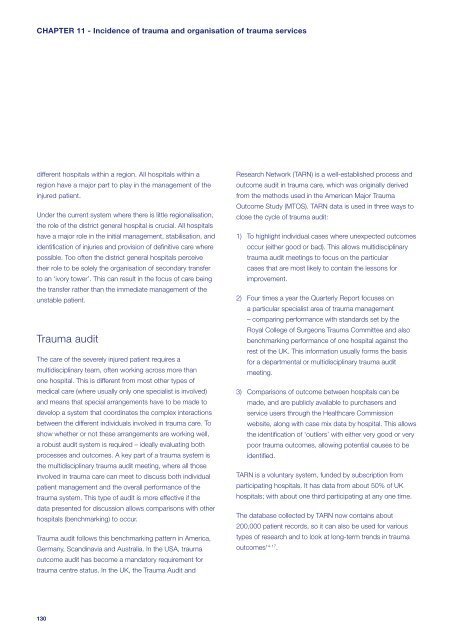NCEPOD: Trauma - Who Cares? - London Health Programmes
NCEPOD: Trauma - Who Cares? - London Health Programmes
NCEPOD: Trauma - Who Cares? - London Health Programmes
Create successful ePaper yourself
Turn your PDF publications into a flip-book with our unique Google optimized e-Paper software.
CHAPTER 11 - Incidence of trauma and organisation of trauma servicesdifferent hospitals within a region. All hospitals within aregion have a major part to play in the management of theinjured patient.Under the current system where there is little regionalisation,the role of the district general hospital is crucial. All hospitalshave a major role in the initial management, stabilisation, andidentifi cation of injuries and provision of defi nitive care wherepossible. Too often the district general hospitals perceivetheir role to be solely the organisation of secondary transferto an ‘ivory tower’. This can result in the focus of care beingthe transfer rather than the immediate management of theunstable patient.<strong>Trauma</strong> auditThe care of the severely injured patient requires amultidisciplinary team, often working across more thanone hospital. This is different from most other types ofmedical care (where usually only one specialist is involved)and means that special arrangements have to be made todevelop a system that coordinates the complex interactionsbetween the different individuals involved in trauma care. Toshow whether or not these arrangements are working well,a robust audit system is required – ideally evaluating bothprocesses and outcomes. A key part of a trauma system isthe multidisciplinary trauma audit meeting, where all thoseinvolved in trauma care can meet to discuss both individualpatient management and the overall performance of thetrauma system. This type of audit is more effective if thedata presented for discussion allows comparisons with otherhospitals (benchmarking) to occur.<strong>Trauma</strong> audit follows this benchmarking pattern in America,Germany, Scandinavia and Australia. In the USA, traumaoutcome audit has become a mandatory requirement fortrauma centre status. In the UK, the <strong>Trauma</strong> Audit andResearch Network (TARN) is a well-established process andoutcome audit in trauma care, which was originally derivedfrom the methods used in the American Major <strong>Trauma</strong>Outcome Study (MTOS). TARN data is used in three ways toclose the cycle of trauma audit:1) To highlight individual cases where unexpected outcomesoccur (either good or bad). This allows multidisciplinarytrauma audit meetings to focus on the particularcases that are most likely to contain the lessons forimprovement.2) Four times a year the Quarterly Report focuses ona particular specialist area of trauma management– comparing performance with standards set by theRoyal College of Surgeons <strong>Trauma</strong> Committee and alsobenchmarking performance of one hospital against therest of the UK. This information usually forms the basisfor a departmental or multidisciplinary trauma auditmeeting.3) Comparisons of outcome between hospitals can bemade, and are publicly available to purchasers andservice users through the <strong>Health</strong>care Commissionwebsite, along with case mix data by hospital. This allowsthe identifi cation of ‘outliers’ with either very good or verypoor trauma outcomes, allowing potential causes to beidentifi ed.TARN is a voluntary system, funded by subscription fromparticipating hospitals. It has data from about 50% of UKhospitals; with about one third participating at any one time.The database collected by TARN now contains about200,000 patient records, so it can also be used for varioustypes of research and to look at long-term trends in traumaoutcomes 14-17 .130
















